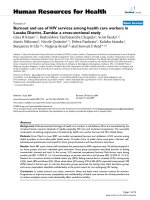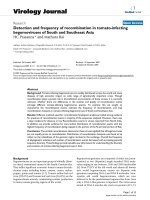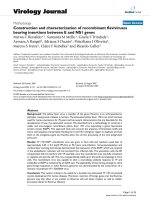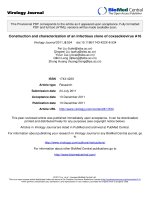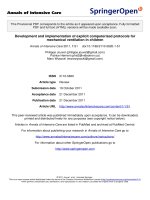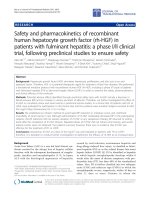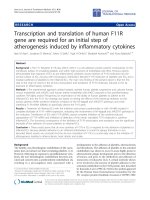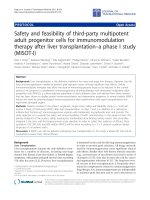Báo cáo sinh học: "Univariate and multivariate parameter estimates for milk production traits using an animal model. I. Description and results of REML analyses" pptx
Bạn đang xem bản rút gọn của tài liệu. Xem và tải ngay bản đầy đủ của tài liệu tại đây (906.29 KB, 16 trang )
Original
article
Univariate
and
multivariate
parameter
estimates
for
milk
production
traits
using
an
animal
model.
I.
Description
and
results
of
REML
analyses
PM
Visscher
R
Thompson
1
University
of
Edinburgh,
Institute
of
Cell,
Animal
and
Population
Biology,
2
West
Mains
Road,
Edinburgh
EH9
3JT;
2
AFRC
Institute
of
Animal
Physiology
and
Genetics
Research,
Roslin
EH25
9PS,
Midlothian,
UK
(Received
5
August
1991;
accepted
3
June
1992)
Summary -
Using
production
records
in
lactations
1-3
from
100
large
Holstein-F‘riesian
pedigree
herds,
parameters
for
milk,
fat
and
protein
yield
in
lactations
1-3
were
estimated
with
REML
using
an
animal
model.
The
number
of
records
for
each
lactation
was
38 811,
26 223
and
16 542
for
lactation
1,
2
and
3
respectively.
Heritabilities
for
the
3
yield
traits
were
similar:
approximately
0.36
in
lactation
1
and
0.30
in
lactations
2
and
3.
Genetic
correlations
between
yield
traits
in
lactations
1
and
2,
for
example
between
milk
production
in
first
and
second
lactations,
were
approximately
0.86.
Genetic
correlations
between
yield
traits in
lactations
2
and
3
were
near
unity.
Genetic
correlations
between
yield
traits
within
lactations
ranged
from
0.58,
for
milk
and
fat
yield
in
lactation
3,
to
0.91,
for
milk
and
protein
yield
in
lactation
1.
Genetic
correlations
between
yield
traits
between
lactations
ranged
from
0.55,
for
milk
yield
in
lactation
1
and
fat
yield
in
lactation
2,
to
0.85,
for
milk
yield
in
lactation
2
and
protein
yield
in
lactation
3.
Environmental
correlations
between
traits
within
lactations
were
approximately
0.95,
and
approximately
0.40
across
lactations.
dairy
cattle
/
animal
model / maximum
likelihood
/
multivariate
analyse
/
multi-
trait
/
multi-lactation
Résumé -
Utilisation
du
modèle
animal
pour
l’estimation
des
paramètres
univariates
et
multivariates
concernant
les
caractères
de
production
laitière.
I.
Description
et
résultats
des
analyses
selon
le
maximum
de
vraisemblance
restreint
(REML).
A
partir
des
données
obtenues
pendant
les
lactations
1
à
3
dans
100
grands
troupeaux
Holstein-
Freisian
inscrits,
les
paramètres
de
production
de
lait,
de
matière
grasse
et
de
matière
protéique
pour
les
lactations
1 à
d ont
été
estimés
par
maximum
de
vraisemblance
restreint
*
Present
address:
Livestock
Improvement
Unit,
Department
of
Food
and
Agriculture,
166-176
Wellington
Parade,
East
Melbourne,
Melbourne
3002,
Australia
(REML)
selon
le
modèle
animal.
Le
nombre
des
données
pour
chaque
lactation
a
été
de
38 811,
26 223
et
16 542
pour
les
lactations
1,
2 et
3
respectivement.
Les
héritabilités
des
3 critères
de
production
ont
été
similaires:
approximativement
0,36
en
première
lactation
et
0,30
en
seconde
et
troisième
lactation.
Les
corrélations
génétiques
entre
les
caractères
de
production
en
lactations
1 et
2,
par
exemple
la
production
laitière,
ont
été
approximativement
de
0,86.
Les
corrélations
génétiques
entre
critères
de
production
aux
lactations
2 et
3 ont
été
pratiquement
égaux
à
1.
Les
corrélations
génétiques
entre
les
critères
de
production
intralactation
ont
varié
de
0,58,
pour
la
production
laitière
et
la
production
de
matière
grasse
en
lactation
3,
à
0,91
pour
la
production
laitière
et
la
production
de
protéine
en
lactation
1.
Les
corrélations
entre
les
productions
à
différentes
lactations
ont
varié
de
0,55,
pour
la
production
laitière
en
lactation
1 et
la
production
de
matière
grasse
en
lactation
2,
à
0,85
pour
la
production
laitière
en
lactation
2 et
la
production
de
protéine
en
lactation
3.
Les
corrélations
non
génétiques
entre
caractères
pour
une
même
lactation
ont
été
approximativement
de
0,95
et
celles
correspondant
à
des
lactations
différentes
ont
été
approximativement
de
0,40.
bovin
laitier
/
modèle
animal / maximum
de
vraisemblance
/
analyse
multivariate
/
multicaractère
/
multilactation
INTRODUCTION
Dairy
cattle
sire
evaluation
in
many
countries
is
carried
out
using
best
linear
unbiased
prediction
(BLUP)
(Interbull,
1988),
while
cows
are
usually
evaluated
separately
using
a
selection
index
type
approach
(eg
Hill
and
Swanson,
1983).
Recently
there
has
been
a
shift
towards
a
joint
evaluation
of
cows
and
bulls,
using
a
so-called
animal
model
(AM).
Some
countries
have
implemented
an
AM
national
evaluation
for
single
traits
(Wiggans
et
al,
1988a,
b;
Ducrocq
et
al,
1990;
Jones
and
Goddard,
1990),
others
are
in
the
process
of
doing
so.
Assumptions
about
the
covariance
structure
of
observations
analysed
with
a
linear
model
are
often
simplified
to
make
computations
feasible.
For
example,
the
USA
(Wiggans
et
al,
1988a),
France
(Ducrocq
et
al,
1990;
Bonaiti
and
Boichard,
1990)
and
Australia
(Jones
and
Goddard,
1990)
use
a
modified
repeatability
model
for
which
a
genetic
correlation
of
unity
is
assumed
between
performances
across
lactations
and
some
(pre)scaling
is
applied
to
later
lactation
records
to
account
for
higher
phenotypic
variances
of
traits
in
later
lactations.
Later
lactation
records
are
given
lower
weightings
by
adjusting
the
error
structure
of
the
observations,
and
milk,
fat,
and
protein
yield
are
analysed
separately
using
this
modified
repeatability
model.
The
potential
loss
in
efficiency
of
selection
by
making
these
assumptions
depends
on
the
true,
unknown,
covariance
structure
of
the
data,
and
on
the
breeding
goal.
By
estimating
relevant
(co)variances
and
assuming
a
particular
combination
of
traits
to
select
for,
the
potential
loss
in
efficiency
of
selection
by
using
simplified
covariance
structures
may
be
quantified.
For
estimating
(co)variance
components
it
seems
desirable
to
use
the
same
model
as
is,
or
soon
will
be,
used
for
the
prediction
of
breeding
values,
ie
an
animal
model.
Few
(co)variance
estimates
from
AM
analyses
have
been
reported;
Swalve
and
Van
Vleck
(1987)
analysed
milk
yield
in
lactations
1-3,
and
Van
Vleck
and
Dong
(1988)
performed
a
multivariate
analysis
on
milk,
fat
and
protein
yield
in
the
first
lactation.
The
aims
of
this
study
were:
1)
to
estimate
parameters
for
milk
(M),
fat
(F)
and
protein
(P)
yield
in
lactations
1,
2
and
3
(L
l,
L2,
L3
);
2)
to
investigate
the
implications
of
the
estimates
for
prediction
of
breeding
values
when
simplified
assumptions
are
made
regarding
covariances
structures.
This
part
of
the
study
is
reported
separately
(Visscher
et
al,
1992).
Estimates
of
correlations
between
different
traits
in
different
lactations,
for
example
between
milk
yield
in
lactation
1
(M
1)
and
fat
yield
in
lactation
2
(F
Z)
have
not
been
reported
before.
In
the
notation
used,
the
number
following
M,
F
or
P
refers
to
lactation
number,
and
the
combination
above,
M1
and
F2,
may
be
written
as
M1F2.
Similarly,
a
multivariate
(MV)
analysis
on
M1,
F,
and
PI
may
be
written
as
analysing
M1F1P1.
MATERIAL
,
First,
second
and
third
lactation
production
records
for
the
period
1979-1987
from
100
large
pedigree
herds
were
extracted
from
the
Milk
Marketing
Board’s
production
files.
Herds
were
selected
on
the
number
of
heifers
present
in
1987,
ie
data
were
extracted
from
those
herds
which
had
the
largest
number
of
first
lactation
cows
in
1987.
Later
lactation
records,
ie
second
or
third,
were
included
only
from
cows
for
which
the
previous
lactations
were
present.
All
cows
were
pedigree
Holstein-Friesian
(HF).
Some
summary
statistics
of
the
data
are
presented
in
table
I.
METHODS
_
Residual
maximum
likelihood
(REML;
Patterson
and
Thompson,
1971)
was
used
to
estimate
(co)variances,
using
programs
based
on
software
written
by
Meyer
(1988,
1989).
Fixed
effects
in
the
mixed
linear
model
were
herd-year-seasons
(HYS)
and
month
of
calving.
Seasons
were
defined
as
4-month
periods,
corresponding
to
the
definition
used
for
the
current
UK
sire
evaluations.
Proportion
of
HF
ancestry
in
the
cow,
age
at
calving
and
lactation
length
were
fitted
as
covariables.
All
animal
effects,
including
those
of
proven
sires.
were
treated
as
random;
this
may
cause
a
(downward)
bias
in
the
estimates,
since
comparisons
between
proven
sires
contribute
to
the
estimate
of
genetic
variance.
For
these
data,
the
possible
bias
in
parameter
estimates
from
treating
all
sire
effects
as
random
was
investigated
elsewhere
(Visscher
and
Thompson,
1992).
The
following
analyses
were
carried
out:
1)
univariate
analyses
for
each
of
M,
F
and
P
in
lactations
1-3.
If
culling
takes
place
on
performance
in
previous
lactations,
the
parameter
estimates
from
univari-
ate
analyses
on
later
lactations
will
be
biased.
Comparing
variance
components
from
these
univariate
analyses
with
components
from
models
that
(partly)
take
account
of
selection
may
give
some
indication
about
what
kind
of
selection
(if
any)
has
acted
on
these
data;
2)
analyses
using
a
repeatability
model
for
each
of
M,
F
and
P
in
lactations
1
and
2.
For
this
model
it
was
assumed
that
the
genetic
correlation
of
performance
between
lactations
was
unity
and
that
variances
were
constant
across
lactations.
A
permanent
environmental
effect
was
fitted
as
an
additional
random
effect
for
these
analyses.
Comparing
results
from
these
analyses
with
results
from
bivariate
analyses
may
show
how
the
(co)variances
are
partitioned
when
a
genetic
correlation
of
unity
between
performances
in
lactations
1
and
2
is
implicity
assumed;
3)
within
lactation
(for
L1,
L2
and
L3)
MV
analyses
for
traits
M,
F
and
P.
An
algorithm
proposed
by
Thompson
and
Hill
(1990)
was
used
to
estimate
(co)variances.
Their
algorithm
was
designed
to
reduce
a
multivariate
estimation
problem
to
a
set
of
independent
univariate
estimations.
Assuming
equal
design
matrices
for
p
traits,
Thompson
and
Hill
(1990)
proposed
performing
q
=
p(p+1)/2
univariate
analyses,
where
the
q
&dquo;traits&dquo;
are
obtained
from
linear
transformations
of
the
p
traits,
and
suggested
finding
a
transformation
matrix
(iteratively)
that
would
stabilise
the
backtransformed
p
x
p
covariance
matrices
from
one
round
to
the
next.
Following
Thompson
and
Hill’s
suggestion,
the
initial
transformation
matrix
was
chosen
so
that
p
=
3
traits
and
3
sums
of
traits
were
analysed.
Subsequently,
after
q =
6
univariate
analyses,
a
canonical
transformation
was
calculated
and
3
canonical
variates
were
formed.
The
next
&dquo;round&dquo;
consisted
of
performing
univariate
analyses
on
these
3
canonical
variates
and
on
3
pairwise
sums
of
the canonical
variates.
The
whole
procedure
was
stopped
after
5
complete
rounds
of
iteration,
since
correlations
on
the
original
scale
changed
very
little
from
round
4
to
5.
Thompson
and
Hill
(1990)
proposed
their
algorithm
for
the
case
of
equal
design
matrices
and
more
than
2
random
effects
in
the
linear
model.
For
the
analyses
described
above,
only
2
random
effects
(animal
and
residual)
were
fitted,
so
that
a
&dquo;standard&dquo;
canonical
transformation
(see
eg
Meyer,
1985)
could
have
been
applied.
Both
methods,
however,
should
give
similar
estimates,
since
the
described
algorithm
was
found
to
be
highly
efficient
(Thompson
and
Hill,
1990);
4)
bivariate
(BV)
analyses
on
all
pairwise
combinations
of
traits
in
different
lactations
Unfortunately,
analysing
the
data
using
a
general
MV
model
(for
example
with
3
traits
in
3
lactations,
ie
for
9
traits)
was
computationally
not
feasible.
Therefore,
selection
bias
is
likely
to
affect
some
of
the
parameter
estimates.
In
particular,
(co)variances
estimated
for
lactation
2
and
3
will
be
biased
if
culling
was
based
on
performance
in
the
first
lactation.
For
all
BV
analyses
the
fixed
effect
structure
was
different
for
both
traits.
For
most
analyses
data
sets
were
too
large
to
be
handled
in
one
single
likelihood
evaluation.
Data
sets
were
therefore
randomly
subdivided
into
subsets
of
herd
groups.
The
estimates
from
each
sample
of
herds
were
assumed
to
be
independent
of
other
estimates.
This
assumption
is
not
strictly
true,
since
some
sires
had
progeny
in
different
subsets.
The
correlation
between
estimates
from
different
samples
depends
on
the
number
of
sires
represented
in
different
samples
and
their
contribution
to
the
parameter
estimates
in
each
sample.
For
analyses
1)
and
2)
data
were
split
into
5
subsets
of
20
herds
each,
for
analyses
3)
into
5,
4
and
2
subsets
(for
L1, L2,
and
L3
respectively),
and
for
4)
into
10
groups
of
10
herds.
For
the
univariate
analyses
and
the
analyses
using
a
repeatability
model,
the
standard
errors
(SE)
of
the
estimates
were
calculated
by
approximating
the
likelihood
surface
at
the
maximum
likelihood
estimates
by
a
quadratic
function
in
the
parameters
of
interest
and
using
the
matrix
of
second
differentials
to
calculate
asymptotic
variances
of
the
estimates
(see
Visscher
et
al,
1991,
for
an
application
and
discussion
of
this
procedure).
For
the
within
lactation
MV
analyses
and
the
BV
analyses,
the
average
(co)variance
estimates
are
presented
with
the
empirical
standard
error
of
the
mean
estimate.
No
weighting
of
estimates
was
applied
because
subsets
were
roughly
of
equal
size
and
there
was
insufficient
information
about
the
sampling
(co)variances
of
the
variance
components
(a
weighting
according
to
the
number
of
records
in
the
analysis
was
tried
and
showed
differences
between
weighted
and
unweighted
means
of
the
order
of
1%
of,tl,1e
:
mean).
It
was
not
clear
how
to
combine
the
different
estimates
efficiently
into
one
overall
(9
x
9)
covariance
matrix,
since
there
was
insufficient
information
about
sampling
variances
and;.culling,
bias. Estimates
of
variances
and
covariances
of
M,
F
and
P
in
lactation
3,
fpre
X8J
llple,
were
available
from
bivariate
analyses
LlL3
and
L2L3
and
from
MV
analyses
within
L3
, all
of
which
were
probably
subject
to
culling
bias.
The
following
method .was chosen
to
create
9 x
9 genetic,
environmental
and
phenotypic
covariance
matrices
which were
consistent
with
each
other:
for
Ll
the
(co)variances
from
analyses
3)
were,used,.
The variances
(diagonals)
in
L2
and
L3
were
taken
from
BV
analyses
LlL2
and.L
lL3
u’sing
the
same
trait
in
each
lactation.
For
example,
the
variance
estimate
for
P3
wa!
iised
from
analysis
PlP3-
Within
lactation
genetic
and
environmental
covariances
between
M,
F
And
P
for
lactations
2
and
3
were
calculated
using
the
variances
as
described
above
and
the
estimates
of
the within
lactation
genetic
and
environmental
correlations.
The
phenotypic
covariances
were
calculated
as
the
sum
of
the
genetic
and
environmental
covariances
thus
created
and
phenotypic
correlations
were
calculated
from
these.
The
same
method
was
used
to
calculate
covariances
between
different
traits
in
different
lactations,
now
using
the
genetic
and
environmental
correlations
estimated
from
BV
analyses.
This
somewhat
arbitrary
way
of
combining
different
estimates
was
found
to
give
fewest
problems
of
negative
definite
covariance
matrices.
It
was
thus
assumed
that
variances
from
BV
analyses
LlL2
and
L1L3,
and
genetic
and
environmental
correlations
between
traits
within
lactations,
were
least
biased
by
selection.
To
summarise
the
calculation
of
the
9 x
9 covariance
matrices:
-
All
genetic,
environmental
and
phenotypic
(co)variances
within
lactation
one
were
from
multivariate
analyses
on
MiFiPi;
-
Environmental
and
genetic
correlations
between
milk,
fat
and
protein
yield
within
lactations
2
and
3
were
from
multivariate
analyses
on
M2F2P2
and
M3F3P3
respectively;
-
Environmental,
genetic
and
phenotypic
variances
for
M2,
Fz,
Pz,
M3,
F3,
and
P3
were
calculated
from
bivariate
analyses
on
MiM2,
F1F2,
PiP
2,
M1M3,
FlF3
and
P1P3
respectively;
-
Environmental
and
genetic
correlations
between
traits
between
lactations
were
taken
from
bivariate
analyses
for
each
pairwise
comparison;
-
All
remaining
phenotypic
covariances
and
phenotypic
correlations
followed
directly
from
combining
the
above
calculated
elements.
Parameters
for
fat
and
protein
content
were
approximated
using
a
first
order
Taylor
series
expansion.
If
x
il
yi
and
x
jl
yj
are
ratio
traits
in
lactations
i
and j
respectively,
then
an
approximation
of
the
covariance
between
those
2
traits
is:
with
CV
the
coefficient
of
variation
(=
a
//1
)
and
rx
,y
the
correlation
between
traits
x
and
y.
Formula
[1]
was
applied
using
estimates
of
the
coefficients
of
variation
and
estimates
of
the
(co)variances
for
the
yield
traits
in
lactations
1-3.
RESULTS
The
main
results
of
the
different
analyses
are
presented
in
tables
II-X.
Heritabilities
for
production
traits
for
the
first
lactations
(table
II)
were
moderate
to
high.
Although
the
genetic
parameter
estimates
from
the
univariate
analysis
for
lactation
2
may
be
biased
by
selection,
increase
in
the
environmental
variance
for
lactation
2
(which
is
unlikely
to
be
greatly
affected
by
culling)
was
striking;
the
ratio
of
environmental
variances
in
lactation
2
to
that
in
1
was
approximately
1.6.
Part
of
the
increase
in
variances
for
the
second
lactation
may
be
a
scale
effect
associated
with
a
larger
mean
(see
also
tables
I
and
XIII
for
means
and
coefficients
of
variation),
since
the
(biased)
genetic
variance
for
lactation
2
is
also
larger
than
the
first
lactation
genetic
variance.
Results
for
lactation
3
also
showed
an
increase
in
environmental
and
phenotypic
variance.
The
estimate
of
the
genetic
variance
in
lactation
3
was
smaller
than
estimates
for
either
lactation
1
or
2,
most
likely
explained
by
ignoring
the
effect
of
culling
from
lactation
1
to ,2
and
from
lactation
2 to 3.
Results
from
analyses
with
a
repeatability
model
are
presented
in
table
III.
Heritabilities
were
slightly
lower
than
those
estimated
from
univariate
analyses
on
first
lactations
only.
The
variance
component
estimates
from
the
analyses
using
a
repeatability
model
(table
III)
may
be
explained
using
the
general
bivariate
model
results
from
tables
V
to
VII ; it
seems
that
both
the
genetic
and
phenotypic
variances
from
the
repeatability
model
were
roughly
the
average
of
the
bivariate
first
and
second
lactation
parameters,
and
the
average
environmental
variance
in
lactation
1
and
2
was
partitioned
into
a
permanent
environmental
and
residual
variance.
If
selection
were
on
first
lactation
performance,
a
repeatability
model
should
account
for
this
selection
effect,
conditional
on
a
genetic
correlation
of
unity
between
first
and
second
lactation
performance.
Table
IV
shows
the
heritability
and
correlation
estimates
from
the
within
lactation
MV
analyses.
Heritabilities
were
similar
to
univariate
(unitrait)
estimates
from
table
II,
as
expected,
and
again
heritability
estimates
from
L2
and
L3
are
expected
to
be
biased
downwards.
Phenotypic
correlations
between
yield
traits
were
very
similar
for
different
lactations,
and
genetic
correlations
were
slightly
lower
in
L2
in
comparison
with
L1,
but
similar
for
L2
and
L3.
Genetic
and
phenotypic
correlations
between
milk
and
protein
yield
were
very
high,
and
environmental
correlations
for
these
traits
calculated
using
the
estimates
from
table
IV
were
close
to
unity.
In
tables
V
to
VII
the
combined
9 x
9 covariance
matrices
are
presented.
The
similarity
between
the
various
3 x
3 lactation
by
lactation
covariance
blocks
is
striking.
In
a
subsequent
study
the
consequences
of
these
results
for
prediction
of
breeding
values
are
investigated
further.
From
table
V
it
seems
that
genetically
L2
and
L3
are
essentially
the
same
for
the
yield
traits,
with
genetic
correlations
between
performances
in
second
and
third
lactations
in
excess
of
0.97.
Compar-
ing
pairs
of
covariances
or
correlations
such
as
M1F2
and
FIM2
shows
that
their
values
are
similar,
which
indicates
that
the
ratio
of
variances
for
traits
in
differ-
ent
lactations
are
similar
for
M,
F,
and
P.
Similar
proportionalities
seem
to
exist
for
environmental
components
(table
VI).
Environmental
correlations
between
traits
within
lactations
were
similar
for
lactations
1-3.
Phenotypic
correlations
between
traits
within
lactations
(table
VII)
are
not
necessarily
the
same
as
those
from
table
IV,
because
of
the
way
this
table
was
constructed.
Little
change,
however,
is
observed.
Phenotypic
correlations
for
MlM2,
F1F2
and
P1P2
were
slightly
higher
than
repeatability
estimates
from
table
III.
Again
the
proportionality
of
the
various
3 x
3 covariance
blocks
is
striking.
In
table
VIII,
heritability
estimates
for
the
9
&dquo;traits&dquo;
are
given
which
are
expected
to
be
least
biased
through
selection,
with
coefficients
of
variation
for
genetic,
environmental
and
phenotypic
effects.
As
before,
lactations
2
and
3
seem
very
similar.
For
all
yield
traits
the
additive
genetic
CV
slightly
decreased
from
Ll
to
L2,
and
the
environmental
CV
increased
from
Ll
to
L2.
Scale
effects
therefore
act
differently
for
genetic
and
environmental
effects,
and
there
seems
to
be
no
single
scale
transformation
which
would
standardise
both
genetic
and
residual
variances
across
lactations.
Many
analyses
that
were
carried
out
yielded
different
estimates
for
the
same
variance
component.
For
example,
an
estimate
for
M1
was
available
from
a
univari-
ate
analysis,
from
a
MV
analysis
with
F,
and
P1,
and
from
6
different
BV
analyses.
All
those
different
estimates
for
the
same
component
are
shown
in
table
IX.
For
each
row
the
2
identical
values
were
from
within
lactation
MV
analyses,
since,
for
example,
M1,
F,
and
PI
were
analysed
multivariately
but
pairwise
combinations
M1F1,
M1P1
and
F1P1
were
not
analysed
bivariately.
Diagonals
in
table
IX
were
from
univariate
analyses
(see
table
II).
As
expected,
the
various
estimates
for
first
lactation
variances
are
very
similar,
since
these
estimates
are
free
from
selection
bias.
Ignoring
first
lactation
information
to
estimate
variances
in
later
lactations
reduces
the
additive
genetic
variances
by
approximately
10%,
most
likely
due
to
culling
bias.
It
is
not
clear
why
the
highest
estimate
for
any
trait
in
L2
was
from
a
combined
analysis
with
the
same
trait
in
L1,
ie
M1M2
gave
the
highest
estimate
for
M2,
and
FlF2
and
PIP2
showed
the
highest
estimates
for
F2
and
P2
respec-
tively.
Using
prediction
equations
for
selection
biases
from
Meyer
and
Thompson
(1984),
no
selection
strategy
for
first
lactation
production
traits
was
found
that
would
produce
these
results.
A
summary
of
the
parameters
calculated
for fat
and
protein
content
(F%
and
P%
respectively),
from
using
equation
(1),
is
presented
in
tables
X
and
XI.
Heritabilities
for
F%
and
P%
were
high
and
were
fairly
constant
across
lactations.
Genetic
correlations
for
F2
%F
3%
and
P2
%P
3%
were
substantially
lower
than
the
genetic
correlations
between
yield
traits
in
second
and
third
lactations.
Parameters
for
first
lactation
traits
(M
1,
F1,
P1,
Fl%
and
P1
%)
were
similar
to
estimates
from
a
5
x
5
MV
analysis
on
all
traits
in
lactation
one
(results
not
presented).
Genetic
correlations
between
protein
yield
and
protein
percentage
were
negative
in
first
and
positive
in
later
lactations,
although
small
in
all
cases.
Univariate
first
lactation
heritabilities
were
similar
to
the
most
recent
UK
estimates
using
a
sire
model
(Meyer,
1987),
but
higher
than
estimates
of
Hill
et
al
(1983)
and
Meyer
(1983
and
1984).
Heritability
estimates
from
pedigree
populations
are
often
higher
than
from
non-pedigree
populations
(Meyer,
1987;
Carabafio
et
al,
1990).
In
dairy
cattle,
heritability
estimates
from
daughter-dam
regression
are
usually
higher
than
estimates
from
paternal
half-sib
comparisons
(Maijala
and
Hanna,
1974;
Van
Vleck
1986),
and
since
the
AM-REML
estimates
are
a
combination
of
both,
this
may
&dquo;explain&dquo;
why
the
AM
estimates
are
higher
than
previous
estimates
from
sire
models.
Swalve
and
Van
Vleck
(1987)
found
AM-
REML
heritability
estimates
of
approximately
0.33
for
milk
yield
in
the
first
3
lactations,
using
a
trivariate
model
and
ignoring
relationships
between
animals
across
herds.
Information
contributing
to
their
heritability
estimates
was
therefore
mainly
from
daughter-dam
comparisons.
Van
Vleck
and
Dong
(1988)
reported
AM
heritability
estimates
of
0.36,
0.35
and
0.33
for
milk,
fat
and
protein
yield
in
first
lactations.
The
increase
of
the
phenotypic
variance
over
time,
additional
to
an
increase
associated
with
a
higher
mean
production,
is
striking;
a
regression
of
the
coefficients
of
variation
(CV)
of
milk
production
in
the
UK
on
time,
using
literature
estimates
from
Hill
et
al
(1983),
Meyer
(1984,
1987)
and
Visscher
et
al
(1991),
shows
a
slight
increase
in
the
phenotypic
CV
from
1976-1987
and
an
increase
in
the
genetic
CV
from
7
to
9%.
The
explanation
for
this
observation
is
not
clear,
although
perhaps
better
estimation
procedures,
in
particular
those
accounting
for
selection
on
the
data,
may
account
for
some
increase
in
the
estimate
of
the
genetic
variance
in
addition
to
a
scale
effect.
Genetic
and
phenotypic
correlations
between
M1,
F1
and
P1
were
slightly
higher
than
the
correlations
found
by
Van
Vleck
and
Dong
(1988).
Genetic
correlations
between
M1,
M2
and
M3
were
almost
identical
to
the
estimates
of
Swalve
and
Van
Vleck
(1987)
and
slighly
lower
than
the
sire
model
estimates
of
Meyer
(1987).
A
small
negative
genetic
correlation
between
protein
yield
and
protein
content
in
lactation
1
was
also
reported
by
Swanson
and
Gnanasakthy
(1991).
Genetic
correlations
between
protein
percentage
and
yield
traits
indicate
that
response
to
selection
for fat
and
protein
yield
can
be
achieved
without
a
reduction
in
the
level
of
protein
percentage,
which
accords
with
the
wishes
of
many
European
dairy
breeders.
The
explanation
for
the
substantially
lower
genetic
correlation
between
content
traits
in
lactation
2
and
3,
ie
for
F2
%F
3%
and
P2
%P
3
%,
compared
with
near
unity
correlations
for
the
yield
traits
is
not
clear.
Applying
equation
[1]
to
FZ%
and
F3
%,
assuming
all
CVs
are
equal
and
genetic
correlations
for
F2F3
and
M2M3
are
unity,
gives:
Therefore
one
explanation
may
be
that
the
within
lactation
correlations,
calcu-
lated
from
within
lactation
MV
analyses
were
biased
downwards
relatively
more
than
the
between
lactation
between
trait
correlations
which
were
calculated
from
BV
analyses.
If
culling
of
first
lactation
cows
were
on
some
linear
combination
of
their
milk,
fat
and
protein
production
in
the
first
lactation
or
on
any
&dquo;culling
variate&dquo;
correlated
with
the
traits
being
analysed,
this
form
of
selection
would
only
partially
be
accounted
for
when
using
a
bivariate
REML
estimation
(see
Robertston,
1966,
for
a
detailed
theoretical
framework
of
a
culling
process).
Therefore
the
BV
second
lactation
parameter
estimates
may
be
slightly
biased.
The
3
traits
considered
were
highly
correlated,
however,
and
the
ratio
of
bivariate
to
univariate
variance
components
was
similar
for
all
traits,
which
suggests
that
the
bias
may
be
small.
Meyer
and
Thompson
(1984)
presented
prediction
equations
of
selection
biases
for
a
one-way
sire
classification,
when
culling
is
on
a
trait
correlated
with
yield
in
the
first
lactation
and
maximum
likelihood
is
used
to
estimate
the
parameters.
Using
their
prediction
formulas
the
selection
bias
was
investigated
for
various
combinations
of
genetic
and
environmental
correlations
between
the
culling
variate
and
the
traits
in
the
BV
analyses.
Selection
intensity
was
calculated
from
the
relative
number
of
cows
that
had
second
lactations.
It
was
found
that
for
a
range
of
parameter
values
likely
to
correspond
with
the
true
population
values
for
milk,
fat
and
protein
yield,
small
biases
were
predicted
for
the
estimates
of
the
genetic
parameters,
but
substantial
biases
(up
to
40%
fo
the
true
values)
could
occur
for
the
environmental
correlations
between
the
2
traits
in
the
analyses.
For
example,
if
the
culling
variate
was
fat
yield
in
lactation
1,
the
percentage
biases
in
the
estimate
of
the
heritability
for
the
trait
in
lactation
2
and
for
the
genetic
and
environmental
correlation
would
be
0,
0.4
and
-4.4
respectively
for
1!11M2,
and
0.2,
0.3
and
4.4
for
PiP
2,
using
the
BV
parameter
estimates
as
true
population
values.
Although
most
of
the
information
used
in
AM-REML
is
a
combination
of
comparisons
between
(paternal)
half-sibs
and
daughter-dam
pairs,
the
effect
of
selection
on
a
correlated
trait
is
unlikely
to
be
large
for
the
range
of
parameters
investigated.
The
parameter
estimates
from
the
bivariate
model
clearly
showed
that
produc-
tion
traits
in
the
second
lactation
are
not
repeated
observations
of
first
lactation
records.
Still,
most
countries
use
a
repeatability
model
in
their
national
AM
eval-
uation,
albeit
with
a
lower
weighting
given
to
second
and
later
lactation
records.
The
weighting
of
later
lactations
seems
the
only
instrument
within
the
present
day
national
AM
evaluations
to
approximate
the
more
appropriate
multivariate
model,
for
which
heritabilities
are
lower
and
variances
are
much
higher
in
later
lactations.
Additional
to
the
implicit
assumption
of
a
genetic
correlation
of
unity
between
first
and
later
lactation
yields,
an
improper
weighting
of
later
lactations
when
using
a
repeatability
model
will
reduce
genetic
progress.
Some
calculations
thereof
are
given
in
a
subsequent
study.
As
described
previously,
the
method
used
to
create
9 x
9 covariance
matrices
from
various
available
estimates
was
somewhat
arbitrary.
Any
combination
of
estimates
is
expected
to
give
sampling
problems,
since
the
traits
are
so
highly
correlated.
For
example,
using
heritability
estimates
from
table
VIII
with
genetic
and
phenotypic
correlations
from
table
IV
gives
3
within
lactation
environmental
covariance
matrices
which
all
are
negative
definite.
Using
estimates
of
environmental
correlations
between
M1,
F,
and
PI
from
Maijala
and
Hanna
(1974),
Meyer
(1985)
and
Van
Vleck
and
Dong
(1988),
determinants
of
the
environmental
correlation
matrix
were
found
to
be
-0.003,
0.012
and
0.03
respectively,
indicating
that
sampling
problems
may
be
expected
with
these
traits.
Still,
when
using
the
method
described
to
calculate
full
9 x
9 covariance
matrices,
sampling
problems
were
not
eliminated:
the
9 x
9 genetic
covariance
matrix
presented
in
table
V
is
not
positive
definite.
However,
the
only
negative
eigenvalue
is
this
matrix
was
relatively
close
to
zero
(—0.04
after
standardising
all
phenotypic
variances
to
unity
for
M1,
F,
and
P1
).
Setting
this
eigenvalue
to
a
small
positive
number
(eg
10-
6)
and
recalculating
all
matrices
showed
very
little
difference
for
all
variance
components.
ACKNOWLEDGMENTS
PM
Visscher
acknowledges
financial
support
from
the
Milk
Marketing
Boards
in
the
UK.
We
thank
WG
Hill
for
many
helpful
comments.
REFERENCES
Bonaiti
B,
Boichard
D
(1990)
Benefits
from
animal
model
evaluation
of
dairy
cattle
in
France.
In:
Proc
4th
World
Congr
Genet
Appl
Livest
Prod,
Edinburgh,
Scotland,
July
23-27,
13,
364-373
Carabano
MJ,
Wade
KM,
Van
Vleck
LD
(1990)
Genotype
by
environment
inter-
action
for
milk
and
fat
production
across
regions
of
the
United
States.
J
Dairy
Sci
73,
173-180
Ducrocq
V,
Boichard
D,
Bonaiti
B,
Barbat
A,
Briend
M
(1990)
A
pseudo-absorption
strategy
for
solving
animal
model
equations
for
large
data
files.
J
Dairy
Sci
73,
1945-1955
Hill
WG,
Swanson
GJT
(1983)
A
selection
index
for
dairy
cows.
Anim
Prod
37,
313-319
Hill
WG,
Edwards
MR,
Ahmed
MKA,
Thompson
R
(1983)
Heritability
of
milk
yield
and
composition
at
different
levels
and
variability
of
production.
Anim
Prod
36, 59-68
Interbull
(1988)
Sire
evaluation
procedures
for
dairy
production
traits
practised
in
various
countries.
Bull
No
3,
Uppsala,
Sweden
Jones
LP,
Goddard
ME
(1990)
Five
years
experience
with
the
animal
model
for
dairy
cattle
evaluations
in
Australia.
In:
Proc
4th
World
Congr
Genet
Appl
Livest
Prod,
Edinburgh,
Scotland,
July
23-27,
13,
382-385
Maijala
K,
Hanna
M
(1974)
Reliable
phenotypic
and
genetic
parameters
in
dairy
cattle.
In:
Proc
lst
World
Congr
Genetics
Applied
to
Livestock
Production,
Madrid,
vol
1,
541-563
Meyer
K
(1983)
Scope
for
evaluating
dairy
sires
using
first
and
second
lactation
records.
Livest
Prod
Sci
10,
531-553
Meyer
K
(1984)
Estimates
of
genetic
parameters
for
milk
and
fat
yield
for
the
first
three
lactations
in
British
Friesian
cows.
Anim
Prod
38,
313-322
Meyer
K
(1985)
Maximum
Likelihood
estimation
of
variance
components
for
a
multivariate
mixed model
with
equal
design
matrices.
Biometrics
41,
153-165
Meyer
K
(1987)
Estimates
of
variance
due
to
sire-herd
interaction
and
environ-
mental
covariances
between
paternal
half-sibs
for
first
lactation
dairy
production.
Livest
Prod
Sci
17,
95-115
Meyer
K
(1988)
DFREML -
A
set
of
programs
to
estimage
variance
components
under
an
individual
animal
model.
J
Dairy
Sci
(suppl
2)
71,
33
Meyer
K
(1989)
Restricted
maximum
likelihood
to
estimate
variance
components
for
animal
models
with
several
random
effects
using
a
derivative-free
logarithm.
Genet
Sel
Evol
21,
317-340
Meyer
K,
Thompson
R
(1984)
Bias
in
variance
and
covariance
component
estima-
tors
due
to
selection
on
a
correlated
trait.
J
Anim
Breed
Genet
101,
33-50
Patterson
HD,
Thompson
R
(1971)
Recovery
of
inter
block-information
when
block
sizes
are
unequal.
Biometrika
52,
545-554
Robertson
A
(1966)
A
mathematical
model
of
the
culling
process
in
dairy
cattle.
Anim
Prod
8,
95-108
Swalve
H,
Van
Vleck
LD
(1987)
Estimation
of
genetic
(co)variances
for
milk
yield
in
first
three
lactations
using
an
animal
model
and
restricted
maximum
likelihood.
J
Dairy
Sci
70,
842-849
Swanson
GJT,
Gnanasakthy
A
(1991)
Estimation
of
genetic
parameters
for
milk
cell
count
and
correlations
with
production
traits
in
Friesian
Holstein
heifers.
In:
Proc
Winter
Meet
Br
Soc
Anim
Prod
(abstr),
pap
168
Thompson
R,
Hill
WG
(1990)
Univariate
REML
analyses
for
multivariate
data
with
the
animal
model.
In:
Proc
4th
World
Congr
Genet
Appl
Livest
Prod,
Edinburgh,
Scotland,
July
23-27,
13,
484-487
Van
Vleck
LD
(1986)
Evaluation
of
dairy
cattle
breeding
programs:
specialised
milk
production.
In:
Proc
3rd
World
Congr
Genet
Ap
PI
Livest
Prod,
Lincoln,
Nebraska,
9, 141-152
Van
Vleck
LD,
Dong
MC
(1988)
Genetic
(co)variances
for
milk,
fat,
and
protein
yield
in
Holsteins
using
an
animal
model.
J
Dairy
Sci
71,
3040-3046
Visscher
PM,
Thompson
R,
Hill
WG
(1991)
Estimation
of
genetic
and
environmen-
tal
variances
for
fat
yield
in
individual
herds
and
an
investigation
into
heterogeneity
of
variance
between
herds.
Livest
Prod
Sci
28,
273-290
Visscher
PM,
Thompson
R
(1992)
Comparison
between
genetic
variances
estimated
from
different
types
of
relatives
in
dairy
cattle.
Anim
Prod
(in
press)
Visscher
PM,
Hill
WG,
Thompson
R
(1992)
Univariate
and
multivariate
parameter
estimates
for
milk
production
traits
using
an
animal
model.
II:
Efficiency
of
selection
when
using
simplified
covariance
structures.
Genet
Sel
Evol
24,
431-447
Wiggans
GR,
Misztal
I,
Van
Vleck
LD
(1988a)
Implementation
of
an
Animal
Model
for
genetic
evaluation
of
dairy
cattle
in
the
United
States.
J
Dairy
Sci
(suppl
2)
71,
54-69
Wiggans
GR,
Misztal
I,
Van
Vleck
LD
(1988b)
Animal
model evaluation
of
Ayrshire
milk
yield
with
all
lactations,
herd-sire
interaction,
and
groups
based
on
unknown
parents.
J
Dairy
Sci
71,
1319-1329
